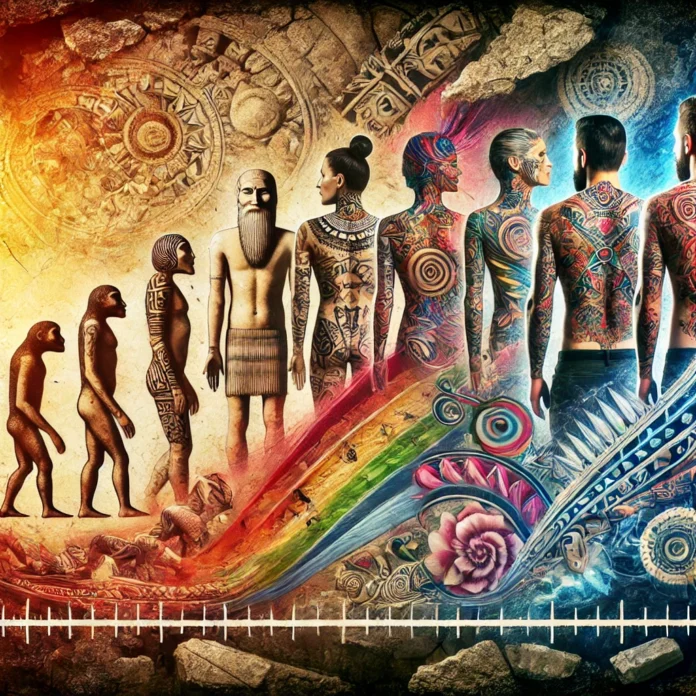Tattoos have evolved from ancient rituals to a booming modern art form, with a history as rich and diverse as the cultures that practiced them. Once seen as a mark of identity, status, or spirituality, tattoos have transformed into a global phenomenon that crosses boundaries of age, gender, and social status. Let’s dive into the captivating journey of tattoos, from their early beginnings to their current place in the world.
Ancient Beginnings: The Roots of Tattooing
Tattoos have been part of human culture for thousands of years, with the earliest known evidence dating back to 3370-3100 BC. The famous “Iceman” Ötzi, discovered in the Alps, bore 61 tattoos, believed to be a form of therapeutic treatment. Similarly, ancient Egyptians adorned themselves with tattoos, as did the early civilizations of Japan, Polynesia, and the Americas. These tattoos often held deep spiritual or cultural significance, symbolizing everything from protection and healing to social status and rites of passage.
In Polynesia, for instance, tattoos were a rite of passage, marking the transition from childhood to adulthood. The intricate patterns and designs, which covered large parts of the body, told stories of a person’s ancestry, achievements, and social position. In Japan, the art of irezumi (traditional Japanese tattooing) evolved into a sophisticated form of body art, often associated with the yakuza but originally rooted in spiritual and cultural practices.
The Middle Ages: A Time of Decline
During the Middle Ages in Europe, tattooing saw a decline as it became associated with paganism and was largely condemned by the Christian church. However, tattoos continued to thrive in other parts of the world, particularly in Asia and among indigenous tribes. Sailors returning from distant lands during the Age of Exploration played a significant role in reintroducing tattoos to the West, bringing back the exotic body art they encountered on their voyages.
The Modern Era: Tattooing Goes Mainstream
The modern history of tattoos began in the late 19th century, with the invention of the electric tattoo machine by Samuel O’Reilly in 1891. This innovation made the process faster, less painful, and more accessible, leading to a boom in tattoo popularity. Tattoos were initially popular among sailors, soldiers, and circus performers, who used them as a form of self-expression and storytelling.
The 20th century saw tattoos become a symbol of rebellion and counterculture, particularly in the post-World War II era. Rock ‘n’ roll, the rise of biker culture, and the influence of iconic figures like Janis Joplin and Johnny Depp helped to push tattoos into the mainstream. By the 1970s and 1980s, tattoos were no longer just for the fringes of society; they were embraced by a wider audience seeking to express their individuality.
Tattoo Renaissance: The Art Form Reimagined
In the late 20th and early 21st centuries, tattoos underwent a renaissance. The stigma once associated with tattoos faded, and the art form began to gain widespread acceptance across all social classes. Tattoo artists became recognized as skilled craftsmen and even fine artists, pushing the boundaries of what could be achieved with ink and skin. The rise of tattoo conventions, television shows like Miami Ink and Ink Master, and the influence of social media further fueled the explosion of tattoo culture.
Today, tattoos are a celebrated form of personal expression. The styles and techniques have diversified, with everything from traditional, tribal, and realism to watercolor, abstract, and minimalist designs. Tattoos are now seen as a canvas for storytelling, with each piece carrying its own meaning and significance for the wearer.
The Future of Tattoos: Technology Meets Tradition
As we look to the future, tattoos continue to evolve. Advances in technology, such as tattoo removal lasers and biodegradable inks, are changing the way we think about permanent body art. Moreover, the global exchange of ideas and styles has created a truly international tattoo culture, where artists and enthusiasts from all walks of life come together to celebrate this ancient art form.
Conclusion
From their origins as spiritual symbols and marks of status to their current role as a mainstream form of self-expression, tattoos have traveled a long and fascinating journey. What was once an underground practice is now celebrated as a legitimate art form, appreciated for its beauty, creativity, and the powerful stories it tells. Whether you view tattoos as a personal statement, a work of art, or a connection to ancient traditions, there’s no denying the profound impact they have had—and continue to have—on cultures around the world.





